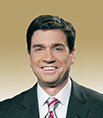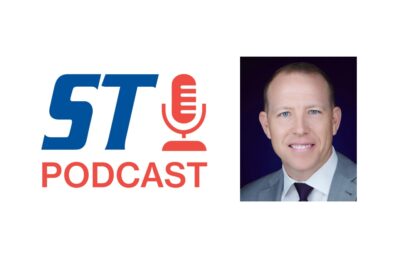
The president and co-owner of LAFC, the Major League Soccer team set to debut in 2018 in Los Angeles, is building a team and stadium from scratch

Tom Penn has the chance to do what few get to do in professional sports: build a team from the ground up. But it’s not just the launch of LAFC, the new Major League Soccer team in Los Angeles, that he’s overseeing. Penn is also helping develop a new downtown stadium set to debut in 2018 when the team begins play. Penn previously spent four seasons as vice-president of basketball operations and assistant general manager of the NBA’s Portland Trailblazers and seven years as assistant general manager of the Memphis Grizzlies in addition to serving as an NBA analyst for ESPN. But in building LAFC, he has had to engage a range of sports and entertainment luminaries as co-owners while convincing new fans to jump on the team’s bandwagon. In this interview, Penn discusses the features of the team’s new stadium, finding fans in Los Angeles and the challenges ahead.
You are building a $350 million, 22,000-seat stadium complex near the Los Angeles Coliseum at USC on the site of the former Los Angeles Memorial Sports Arena. How were you able to negotiate such a prime location?
It was a function of timing. Everyone agreed it was time for the old arena to be demolished and to find a new and better use. USC had recently taken possession of the Sports Arena and we entered negotiations to become the sole operator to take it off their hands. We will sublease it from USC for 98 years. The timing was right. That land was pre-approved for a soccer-specific stadium. The environmental work had been done and it gave us the chance to modify the existing entitlement rather than going through a long and arduous process with the state. And we had tremendous political support. The fact that we were investing so much private money into this part of town was very well received.
What were some features you absolutely wanted in your stadium?
We wanted the stadium to be an expression of the brand. We’re truly the city’s team. We’re in the heart of the city with our location. We’re more of an urban, of-the-city type team so we wanted to be more of an outdoor arena than a stadium itself. In many of the soccer stadiums built today the energy gets lost as the stands slope away gradually from the field. We requested our architects to build stands as close to the field as possible and with the steepest rake of the bowl as possible so there’s this real sense you’re on top of the action. It’s an intimate setting. The roof is designed to keep the sun out and the noise in and focus all the energy on the pitch. It should be very loud and intimidating and an intimate atmosphere.
Will the steepness of those seats limit you for other types of events?
I think it should all help. The more proximate you are to the field the better. It is designed for other events, so we consulted with many of the big concert promoters to figure out what they needed for it to be an attractive concert venue. For example, we have a permanent stage built in below our supporters section in the north end of the stadium. We’ve got a roof that is strong enough to support rigging for concerts. We’ve got a super nice green room as part of our back of house. We’ve got these tremendous hospitality areas, which is really what’s important: the ability to have a first-class experience whether it’s a soccer game, a concert, a rugby match or whatever is going on.
You’re also building some attached structures to complement the stadium. What are your plans there?
We’re building an ancillary structure attached to the stadium that has an international food hall, sort of “the world’s food in the world’s city around the world’s game” that will be open 365 days that will be a destination unto itself. We have a significant retail store that will be a soccer superstore. And then we have a conference and event center with a rooftop deck that connects to our club spaces. We sit in Exposition Park and there are 6 million visitors per year that roll through there. Our front door will be adjacent to the front door of the iconic Coliseum and we’re right across the lawn from the California Science Center museum and the space shuttle Endeavor, its new exhibit. So there’s all sorts of activity in the area that’s very exciting.
You have been engaging supporters’ groups from the beginning for decisions from team colors to stadium design. What have you learned from them?
We’ve had them engaged and involved from the beginning, particularly as it relates to their end of the stadium. It’s almost like they get a whole quadrant to themselves purpose-built with their input. We have a dedicated supporters bar above their section, which is the only one of its kind that proximate to the view of the pitch. The supporter section itself is over 3,200 seats. We’ve heard loud and clear that they want to have the option to stay standing. And they want cheap beer and good food. [Laughs.] And charging stations.
Los Angeles is a big city with a lot of options for people’s attention. What is your strategy to gain fans for LAFC?
This is such a robust market. It truly is the world’s city with so many ethnic populations here. People come from all over America to chase their dream and achieve it here. Our mission is to unite the world’s city through the world’s game. We feel like nothing speaks to every aspect of this city than this game. So we just want to authentically connect with the community by No. 1, our location, and No. 2, our commitment to being L.A.’s team. We’ve had a tremendous response.
How will you differentiate yourself from the other MLS team in the city, the L.A. Galaxy?
The first differentiator is our location. We’re in the heart of the city. We’re on the light-rail line. And we’re right next to the Coliseum in the urban core. Then, the quality of our stadium is second to none in North America. And globally for a stadium of our size there’s nothing like this.
Are there any other team launches you’ve turned to for a blueprint in creating this team?
I personally lived in Portland and I experienced the Timbers as they sprung into existence and captured that market. From a fan experience standpoint—because of the Timbers Army and because of their unique connection to the sport—that’s an amazing experience and one we have our eye on very carefully and one we’d love to emulate. And I’d say New York City FC had a very successful launch in a different way because they don’t have their own home but were able to come in and be the next team in New York and become really relevant really quickly.
You have several famous co-owners on board, from European soccer team owners to sports stars like Magic Johnson and Mia Hamm to actor Will Ferrell. Why were you casting such a wide net for co-owners?
When I say we want to be representative of L.A. and authentically L.A.’s team, that starts with ownership. To have the diversity we have, the various industries and expertise, for me it’s the greatest contact list. All those folks are engaged, enthusiastic and supportive.
How involved are they all on day-to-day decisions?
Certainly the managing owners I’m in contact with every day. Peter Guber, our executive chairman, has his fingerprints on everything. We have an office together. He’s involved every day. Larry Berg is our lead managing owner. He’s very involved on behalf of his co-managing owners. I’d say the rest of the group is engaged in their areas of expertise as needed or as they want to influence. Will Ferrell is a good example. Will’s been very supportive and active at our youth level and in some of our fan activities and then he’ll go on Jimmy Fallon and do something very noteworthy. Mia Hamm has been involved in some of our strategic partnerships in soccer. She and Nomar Garciaparra weigh in a lot as to how we’re going to approach and build our player culture.
What do you think of MLS’ slow-growth strategy?
They’ve been very measured and thoughtful about it. There’s such a robust appetite for the sport right now in America. If you look at the group of owners who have invested now across MLS, it’s really a who’s who of professional sports ownership in America. There’s such an interest with so many communities wanting to add this sport. We’ve hit that tipping point where soccer is no longer the sport of the future, it’s the sport of now. The commissioner’s office is doing a great job of determining where and how best to expand.
What was the transition like for you to go from the NBA to MLS? Do the leagues translate pretty well?
Well, most of my experience in the NBA was in roster building and talent acquisition. We’re just beginning that process now. It’s equally complicated in a different way in MLS. It is in its essence a salary cap structure. And I’m personally familiar in operating in that system. But this is a different challenge. There’s quite a bit less money on a salary cap scale compared to the NBA. And it’s global free agency. So there’s a global world of talent and opportunity, and that’s a challenge for us to get our arms around.
Your stadium was initially proposed by LA 2024 as a venue for swimming in its Olympic bid but was changed to a soccer venue. What is your relationship with the bid and why was there a shift in plans?
We’re very supportive of the Olympic bid, obviously. They’ve got an incredible plan that creates mini campuses of venues. The fact that we’re attached to the Coliseum makes us front and center with our building. As the plans evolved, they found a better opportunity for a swim stadium since it was just going to be a temporary venue. And they’ve chosen a temporary venue right on USC’s campus. That freed up their ability to then host soccer matches in our stadium, which makes a heck of a lot of sense. They plan to play the championship match still in the Rose Bowl and then they’ll play regionally. And our venue should be great for that.











 Copyright © 2025 by Northstar Travel Media LLC. All Rights Reserved. 301 Route 17 N, Suite 1150, Rutherford, NJ 07070 USA | Telephone: (201) 902-2000
Copyright © 2025 by Northstar Travel Media LLC. All Rights Reserved. 301 Route 17 N, Suite 1150, Rutherford, NJ 07070 USA | Telephone: (201) 902-2000